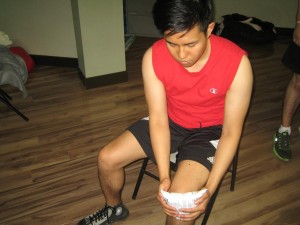Pes anserine bursitis is the inflammation of the bursa which is located between the shinbone and the three tendons of the hamstring muscles that is found inside the knee. The bursa is a smooth sac that helps in preventing bones and the ends of joints and skin from rubbing with each other during any form of activity. Pes anserine bursitis involves swelling, pain, tenderness and redness inside the knee, about 2-3 inches below the joint.
Causes of pes anserine bursitis
Pes anserine bursitis is common among athletes such as runners as well as those who are suffering from osteoarthritis face a higher risk for developing this condition. Possible factors that can cause pes anserine bursitis including the following:

- Incorrect training such as lack of stretching exercises before doing strenuous long distance running and an abrupt increase in mileage.
- Being obese
- Hamstring muscles are tight
- Out-turning of the knee or the lower leg
- A medial meniscus tear and knee osteoarthritis
Symptoms of pes anserine bursitis
- Pain that gradually develop and can be felt inside of knee or in the center of the shinbone, approximately 2-3 inches below the knee joint.
- Pain that increases when engaging in exercises or climbing stairs.
Treatment and home remedies
- Rest the affected area until bursitis is totally healed.
- Apply an ice compress or pack of frozen vegetables at regular intervals at least 3-4 time in a day for 20 minutes per session and then remove after 20 minutes. Repeat this procedure as often as possible for the first two days in order to relieve the symptoms. If you want to learn more about the effectiveness of cold therapy on similar conditions, read here.
- Take over-the-counter medication to minimize pain and inflammation such as anti-inflammatory drugs in order to reduce inflammation found around the pes anserine bursa.
- Physical therapy is another treatment option for bursitis since it will strengthen the muscles found around the joints of the knee particularly the hamstring muscles in order to minimize episodes of pes anserine bursitis
Exercises for pes anserine bursitis
- The heel slide is an exercise that helps gain control of the hip joint and helps restore range of motion by stretching of the muscles on top of the thigh. It is done by sitting on the floor with legs against the floor and straight out in front, then slide slowly the heel toward the buttock by pulling the knee toward the chest as the heels slides on the floor, then return the leg to its original position.
- Hamstring stretch is an exercise that provides flexibility to the muscles found in the back of the thigh and knee. Place one leg on the floor through the doorway while the other leg is propped on the wall. The buttocks should be close to the wall as possible and hold the position for a few seconds, and then change the leg.
